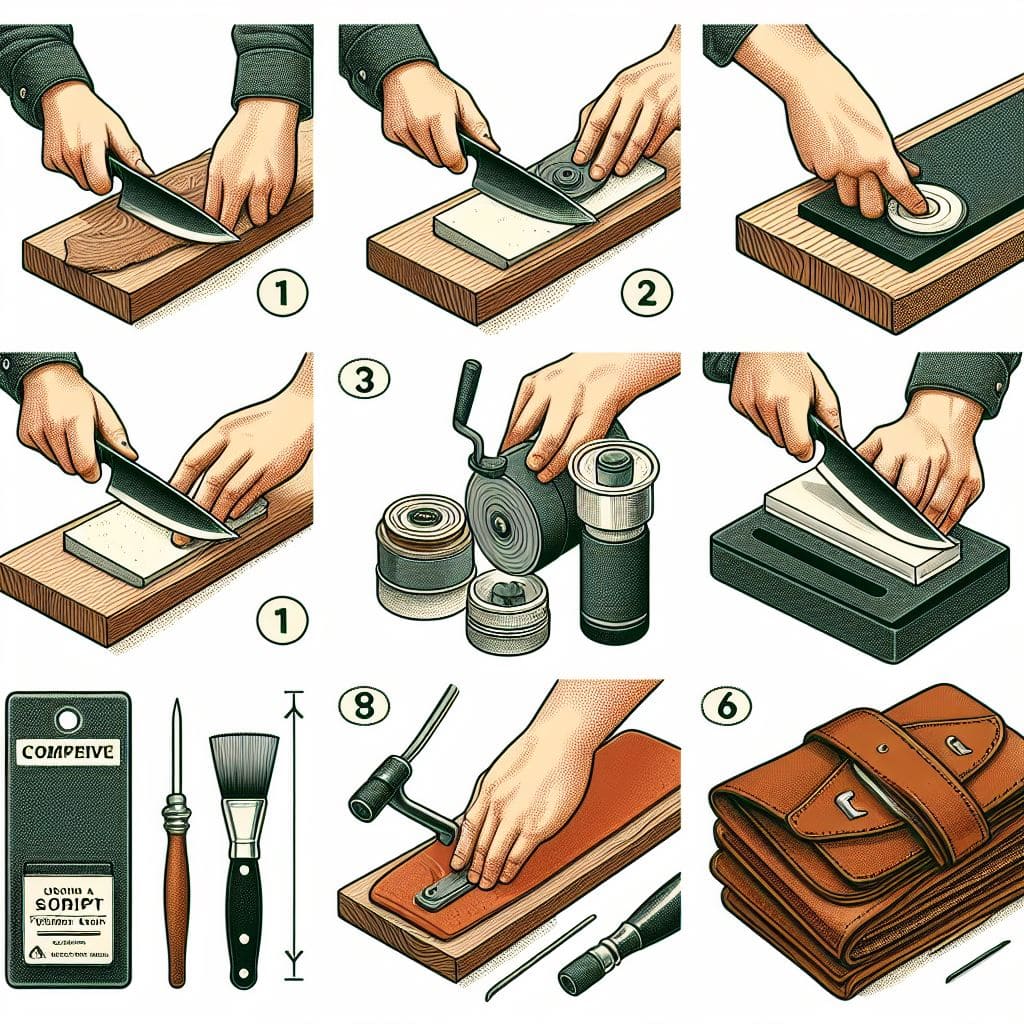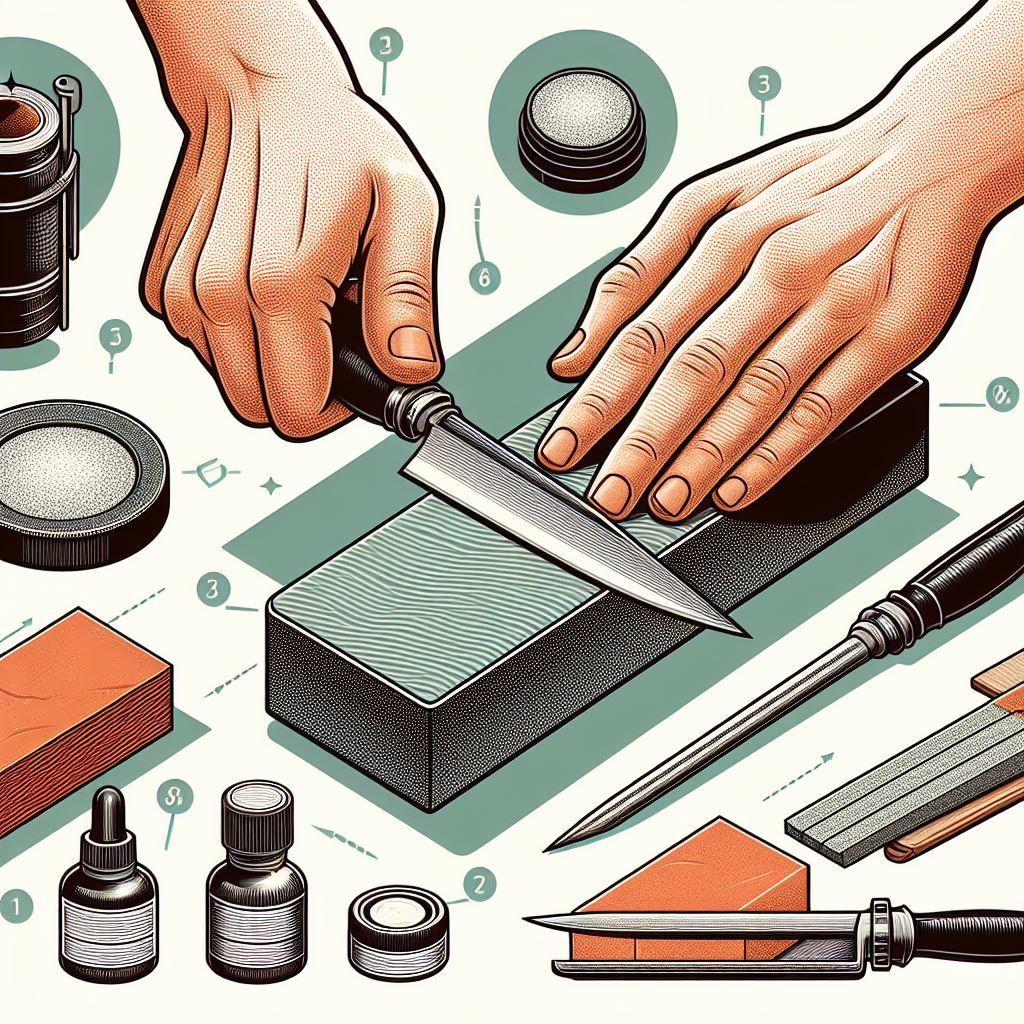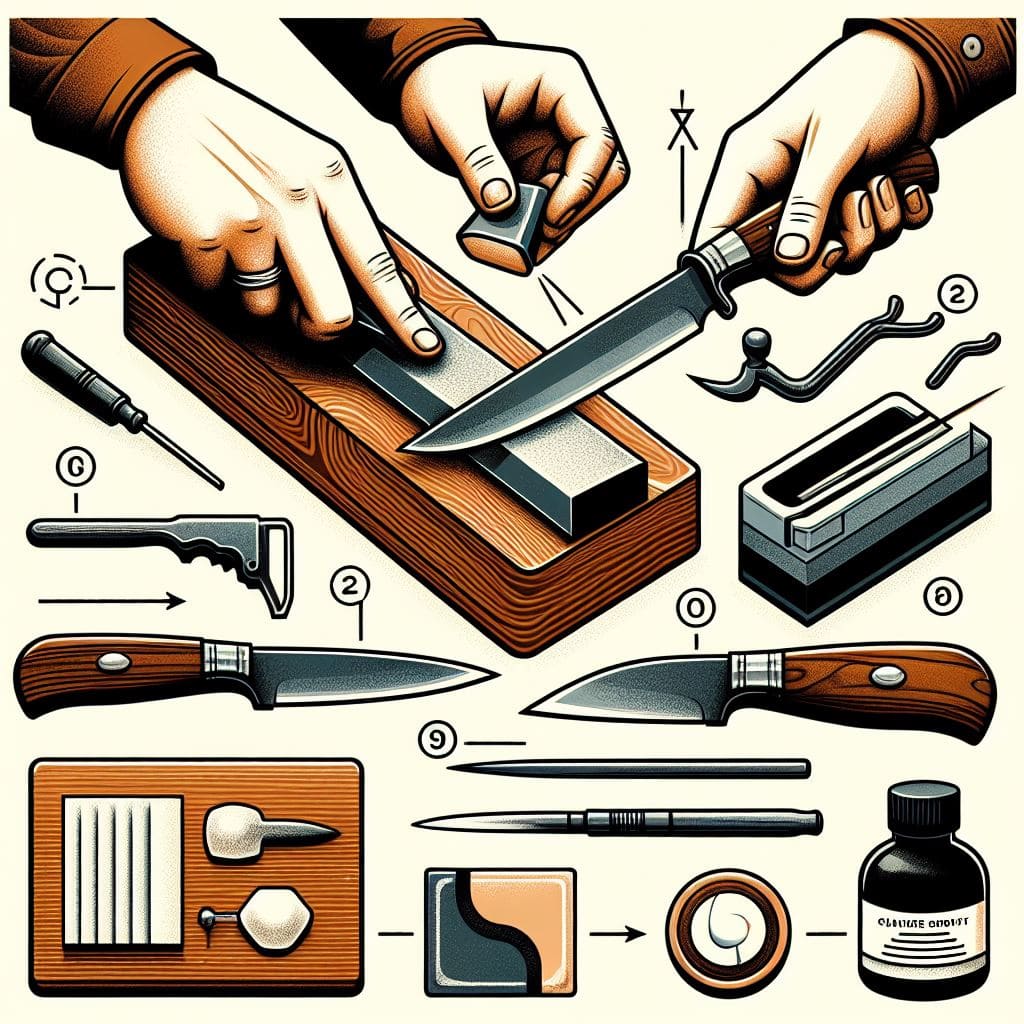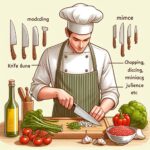To sharpen a hook knife, use a round sharpening stone or strop with a compound that matches the curve of the blade. Maintain a consistent angle and stroke along the edge for an even sharpness.
Sharpening a hook knife—a specialized tool for carving and woodworking—demands precision and patience. Perfecting the knife’s edge is critical for clean cuts and efficient work. Regardless of your skill level, knowing how to maintain your tools is an essential aspect of craftsmanship.
A sharp hook knife can mean the difference between a mediocre piece and a masterpiece. A well-rounded introduction to this topic not only prepares you for the sharpening process but also underscores the importance of keeping your tools in top condition for optimal performance and safety. Dive into the nuances of blade care and ensure every cut you make is with the utmost accuracy.

Introduction To The Hook Knife
The hook knife, a vital component in the toolbox of many woodworkers and craftsmen, is uniquely designed to carve intricate designs into wood and other soft materials. With its distinctive curved blade, this specialized tool allows artisans to execute precise cuts and hollows, creating everything from detailed sculptures to utilitarian wooden spoons.
Understanding The Hook Knife: Design And Uses
At its core, the hook knife’s design features a curved cutting edge which serves a specific purpose: to facilitate the carving and shaping of rounded surfaces with ease. The unique shape of the blade allows for a greater level of control and maneuverability, making it an ideal choice for:
- Spoon and bowl carving
- Hollowing out concave shapes
- Detailed woodworking tasks
- Carving intricate patterns and designs
The versatility of this tool extends beyond woodworking and can enhance the craftsmanship in other creative domains such as sculpting, leatherworking, and even ice carving.
Importance Of Keeping A Hook Knife Sharpened
A sharp hook knife is a craftsman’s ally. The effectiveness and safety of the tool are directly influenced by its sharpness. A well-maintained edge reduces the amount of force you need to apply, thus minimizing fatigue and the likelihood of accidents. Precision and efficiency in carving tasks are assured by a sharpened hook knife, allowing:
- Smooth and controlled cuts
- Decreased effort during use
- Fine finishes and highly detailed work
Additionally, a sharpened knife prolongs the tool’s life, ensuring its availability for countless projects to come. Regular maintenance keeps the blade at peak performance and reflects the dedication of the craftsman to their art.
Preparing For The Sharpening Process
Welcome to the craft of maintaining and sharpening your tools, where mastery starts with preparation. A hook knife, essential in the art of wood carving, requires a keen edge to perform at its best. The sharpening process is both a skill and an art form, necessitating diligence, accuracy, and a methodical approach. Engaging in this process ensures that your hook knife remains a reliable tool for both intricate and robust carving tasks. Let’s equip you with the knowledge and steps to prepare effectively for sharpening your hook knife.
Safety First: Protecting Yourself And Your Workspace
Before you embark on sharpening your hook knife, safety should take precedence. An orderly workspace and proper protective gear diminish the risks of accidents. To ensure your protection:
- Wear gloves to safeguard your hands from potential cuts.
- Utilize safety goggles to prevent any metal filings or wood chips from causing eye damage.
- Ensure adequate lighting to enhance visibility, reducing the chance of a mishap.
- Maintain a clean and organized workspace free from clutter, providing a safe and efficient sharpening environment.
Gathering The Necessary Sharpening Supplies
Assembling the right supplies is crucial for effective sharpening. The tools you select, from sharpening stones to honing oils, influence the final sharpness and longevity of your hook knife’s blade. Gather the following items:
- Sharpening stone: A curved stone matched to the contour of your hook knife’s blade is ideal.
- Honing oil or water: Depending on the nature of your sharpening stone, apply appropriate lubrication to enable a smooth sharpening action.
- Leather strop: Used for the final polishing and refinement of the blade’s edge.
- Non-slip mat: Keeps your sharpening stone stable during the sharpening process.
Inspecting The Hook Knife: Identifying Areas That Need Attention
The first step in sharpening your hook knife is a thorough inspection of the blade. This determines the current state of the edge and highlights areas requiring focused sharpening. Perform the inspection under good lighting for maximum visibility, and look for:
- Nicks or flat spots: Areas where the blade may have been dented or flattened.
- Dullness: A dull edge reflects light, offering a visual cue to its sharpness.
- Rust or discoloration: These imperfections can impair the sharpening process and need addressing before proceeding.
- Blade curvature: Ensure uniformity and symmetry along the curve for optimal performance.
Each step in this initial preparation stage sets the stage for a successful sharpening session, ensuring that your hook knife is restored to its peak condition for carving excellence.
Step-by-step Guide To Sharpening Your Hook Knife
Mastering the art of sharpening a hook knife is essential for woodworkers, spoon carvers, and anyone invested in maintaining their tools for peak performance. With the right technique and tools, you can transform a dull blade into a precision cutting instrument. Follow this step-by-step guide to effectively sharpen your hook knife.
Securing The Hook Knife For Sharpening
First, ensure your safety and the effectiveness of your sharpening by securing the hook knife properly. Use a vise or a clamp to hold the knife steady, padding the jaws with leather or cloth to prevent damage. A secure grip allows for precise sharpening without unnecessary movement.
Selecting The Correct Sharpening Tools
Selecting the right sharpening tools is crucial. For hook knives, use a rounded slip stone or a strop that matches the inner curve of the blade. The stone’s grit should be suitable for the degree of sharpening required—coarse for very dull blades and fine for honing a maintained edge.
The Sharpening Technique: Angles And Motion
Understanding the correct angle and sharpening motion is vital. Hold the blade at a consistent angle, typically around 15-20 degrees. Use a sweeping motion, following the curve of the blade while maintaining constant contact with the sharpening stone. Regular checks ensure the angle remains correct throughout the process.
Maintaining The Inside Curve Of The Hook Knife
The inside curve presents a unique challenge. For this area, use a round file or ceramic rod that fits snugly within the curve. Move it gently along the curve’s length, applying light but firm pressure. Ensure even sharpening by periodically inspecting the edge from different angles.
Finishing Touches: Honing And Polishing The Edge
As you approach the desired sharpness, shift to finer stones or a leather strop for honing. Apply a polishing compound to the strop to refine the edge further. Smooth, consistent strokes will result in a mirror-like finish that’s not only sharp but also aesthetically pleasing.
Testing The Sharpness: Ensuring A Job Well Done
Finally, test the blade’s sharpness on a piece of softwood or paper. A well-sharpened hook knife should cut smoothly and without resistance. Adjust your technique and repeat the process if necessary to achieve the perfect edge.

Maintenance Tips For Your Hook Knife’s Edge
Understanding how to maintain the edge of a hook knife is crucial for anyone who frequently engages in woodworking or carving projects. A well-maintained hook knife not only makes your work more efficient but also ensures safety during use. By adhering to a regimen of routine practices, proper storage, and recognizing signs of dullness, you can keep your hook knife in optimal condition. Embrace these maintenance tips to retain that fine edge and you’ll find that your hook knife remains a reliable tool in your crafting arsenal.
Routine Practices For Keeping Your Knife Sharp
Maintaining a sharp edge on your hook knife is indispensable for peak performance. Here are some essential practices:
- Clean the knife after every use, wiping away debris and moisture that could corrode the blade.
- Perform regular honings with a leather strop or honing rod to realign the edge.
- If using a sharpening stone, ensure it’s of appropriate grit – start with a coarser stone and progress to a finer one for a polished edge.
Sticking to these routines guarantees that your hook knife remains ready and sharp for every task at hand.
Storing Your Hook Knife Properly
Optimal storage conditions significantly contribute to the longevity of your knife’s edge. Consider the following guidelines:
- Store the knife in a dry environment to prevent rust and corrosion.
- Use a protective sheath to safeguard the blade and minimize the risk of accidental injuries.
- Avoid contact with other tools or hard surfaces that could nick or dull the blade.
This careful approach to storage will protect the delicate edge from unnecessary wear.
When To Sharpen: Recognizing The Signs Of Dullness
Being alert to the telltale signs of blade dullness is crucial in maintaining your hook knife’s edge:
- Difficulty in cutting or the need to apply excessive force indicates a blunt edge.
- A shiny edge on the blade’s curve often suggests dullness.
- Skinning a fingertip lightly over the edge (carefully, to prevent cutting yourself) can help you feel for nicks or a smooth edge.
Recognizing these signs means it’s time to sharpen your knife to restore its pristine cutting ability. Regular maintenance paired with vigilant care ensures your hook knife remains a trusty tool through all your crafting endeavors.
Advanced Techniques And Considerations
Welcome to the world of advanced sharpening techniques for hook knives—a vital skill for woodcarvers and craftsmen aspiring to maintain their tools in peak condition. Mastering the intricacies of honing a hook knife not only ensures cleaner cuts but also prolongs the life of the blade. In this section, we delve into next-level strategies and thoughtful considerations that will elevate your sharpening skills.
Troubleshooting Common Sharpening Mistakes
Even seasoned woodworkers can encounter issues while sharpening hook knives. The unique shape often requires a customized approach. Common missteps include using inappropriate sharpening tools, inconsistent angles, and excessive pressure which can lead to an uneven edge or even damage the blade. Let’s explore some smart fixes:
- Use the right tools: Decide on diamond stones, ceramic rods, or custom strops that match the curvature of your hook knife.
- Maintain angle consistency: Always sharpen at the manufacturer’s suggested angle for optimal performance.
- Light pressure: Apply gentle pressure to prevent removing too much metal, which can alter the blade’s shape.
Sharpening Curved Blades Vs. Straight Blades
Sharpening a hook knife demands more attention than its straight-bladed counterpart because of its arched shape. Follow these guidelines to ensure successful resharpening:
| Curved Blade (Hook Knife) | Straight Blade |
|---|---|
| Employ round files or curved honing tools | Use flat whetstones or bench stones |
| Adopt a rotational sharpening motion to match the curve | Maintain a stable, linear motion throughout the sharpening process |
| Focus on one section of the curve at a time | Sharpen the entire edge in a uniform pass |
Exploring Professional Sharpening Services
For those who demand precision and longevity in their blades’ performance, professional sharpening services offer a solution. Specialists in sharpening can leverage their experience, precise tools, and techniques to bring back the razor-sharp edge your hook knife needs. Consider these perks of professional services:
- Access to expert sharpeners with deep understanding of blade geometries.
- Utilization of advanced equipment for consistent, high-quality results.
- Time-saving solution for busy craftsmen wanting to focus on their craft.
Mastering The Art Of Knife Sharpening
Sharpening a hook knife is more than just a task; it’s a valuable skill that blends together patience, precision, and practice. As we’ve delved into the intricacies of this process, it’s evident that the journey to mastery is as rewarding as the outcome. With your hook knife honed to perfection, not only will your cuts be cleaner and your work more efficient, but the deep satisfaction of maintaining your tools will enrich your craft. Let’s reflect on the skills acquired and the virtues cultivated through this sharpening journey.
Reflecting On The Skills Acquired
Throughout the learning curve, several skills emerge. Users develop keen eyes for the subtle cues that indicate a blade’s readiness. The experience teaches the nuances of metal and wood, as well as the importance of choosing the right sharpening stones and honing techniques. Mastering these skills ensures that your tools are always at their best, thus elevating the quality of your work.
- Visual inspection for dullness or damage
- Angle consistency for optimal sharpening
- Pressure application for effective abrasion
- Burr detection for precise edge refinement
Cultivating Patience And Precision In Craftsmanship
Sharpening a hook knife is an art that demands both patience and precision. Taking the time to perform slow, deliberate strokes across the sharpening stone results in a refined edge that mere hastiness cannot achieve. Precision, in guiding the knife at the correct angle, ensures a sharp and durable edge. Embrace the process – each session enhances your craftsmanship, making every subsequent sharpening swifter and more efficient. This dedication to quality is a testament to your commitment as a craftsman.
| Virtue | Impact on Sharpening |
|---|---|
| Patience | Ensures thorough and careful sharpening |
| Precision | Guarantees a consistently sharp edge |
The journey to sharpening proficiency is as enriching as it is practical. Listeners become learners, and movements become muscle memory. Over time, the craftsperson and the hook knife work in unison, each sharpening session strengthening the bond between creator and tool.

Conclusion
Sharpening a hook knife is easier than it seems. With the right tools and technique, you can maintain a razor-sharp edge. Remember, patience and practice will perfect your skill. Keep safety at the forefront while perfecting this essential craft task.
A well-sharpened hook knife is a joy to work with and elevates your carving projects.
Frequently Asked Questions On How To Sharpen A Hook Knife
Can You Sharpen A Hook Knife?
Yes, you can sharpen a hook knife using a round file or a honing stone designed for curved blades. Regular sharpening maintains its effectiveness.
What Is The Best Sharpening Stone For Hook Knife?
The best sharpening stone for a hook knife is a round, contoured stone designed for curved blades, often labeled as a slipstone or gouge stone.
How Do You Sharpen A Roofing Knife?
To sharpen a roofing knife, use a whetstone or a diamond sharpener. Gently glide the blade across the coarse side, then refine the edge on the fine side. Maintain consistent angles for a sharp, even edge. Regular sharpening ensures precise cuts and prolonged tool life.
What Is A Hook Knife?
A hook knife is a specialized tool with a curved blade for carving and shaping wood, often used in spoon-making or bowl carving. Its design allows for controlled, precise cuts.







